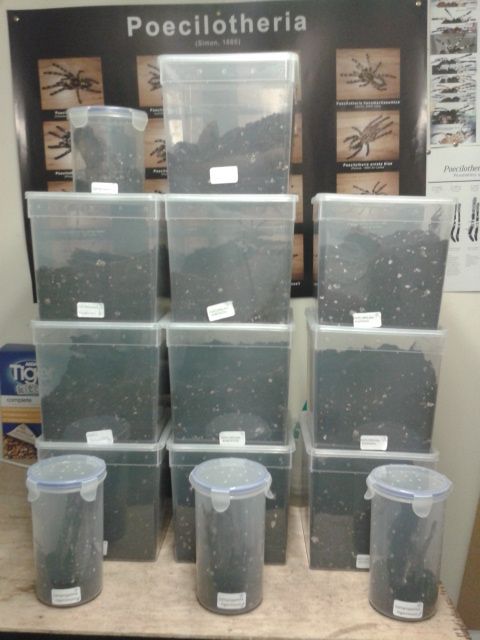Announcement
Collapse
No announcement yet.
Finally some photos.
Collapse
X
-
You have some of my favourites there
There are a few things wrong that I think that can be seen from the photos although this may be just the angle that they were taken.
C. Huahini, C. Perezmilesi and A geniculata look to be on the wrong type of substrate.
Is it a sand and gravel mix ?
C. Huahini, C. Perezmilesi are both burrowers and need a deepish substrate so that they can make a burrow and also need a reasonable level of humidity, which looking at the type of substrate that you are using just wont happen.
C huahini would need about 4-6 inches of substrate, it will usually make a burrow and then web extensively around the entrance.
C perezmilesi as it is a dwarf species will only need a small tub with maybe 2-3 inches of substrate and will maybe have a few strands of webbing spread about.
A geniculata just needs it slightly humid (the substrate being used isnt that ideal for that) and rarely burrows
Has the P Cambridgei got an arboreal retreat ?
To see a cambridgei on the floor is IMHO very unusual as it is a relatively secretive arboreal species.
Most likely you will now show complete photos of the tubs and i'll be proven wrong about everything.
This how I keep some of my juvie Chilobrachys and a burrow entrance of a sub female C huahini


-
Hi Pete
Now I have alittle more time I can try and answer all you queries about my set up for myT’s
The substrate is not quite as coarse as it appears on my photos.
I use “PRO-REP spider life” substrate with a little spagnum moss mixed in
Occassionally i have used “monkfield Tortoise terain”which is a mixture of topsoil, sand and limestone grit.
With thePereimilesi I have taken your advice and increased the depth of the substrate to allow burrowing, I plan to do the same with my Huahini as soon as I can get a new tub at the weekend.
And for theCambridgei he/she does have an aboreal retreat in the form of a long thin peice of slate angled from top to bottom with artificial plants hanging over the top, (see photo) but as you pointed out he/she often spends much of the time on the bottom of the tub and will often come down to eat the crickets, do you think my set up is ok? Or any advice would be greatly appreciated.
And even though they all seem to be feeding well i am aware there is a difference between “surviving” and “thriving”, but as im new to keeping T’s I want to do thebest i can for them.
Any advise from other members would also be appreciated.
Thanks
steve
Comment
-
Originally posted by steve borthwick View PostAnd for theCambridgei he/she does have an aboreal retreat in the form of a long thin peice of slate angled from top to bottom with artificial plants hanging over the top, (see photo) but as you pointed out he/she often spends much of the time on the bottom of the tub and will often come down to eat the crickets, do you think my set up is ok? Or any advice would be greatly appreciated.
And even though they all seem to be feeding well i am aware there is a difference between “surviving” and “thriving”, but as im new to keeping T’s I want to do the best i can for them.
In my (not so) humble opinion the set up for the cambridgei is wrong because of the slate that you are using. There are species of terrestrial tarantula's that do not mind slate or rock to hide beneath but there are no arboreal species that I know of that prefer to use slate or rock as a hide. (which isnt saying that there isnt any that do)
The cambridgei spending time on the bottom is not normal behaviour for an arboreal species and I would suggest that you change the slate for an upright piece of bark at a minimum but ideally either a cork tube or a similar hand made version.
Cork tubes can be bought online or in the local reptile shop but I prefer to collect bark from the local woods, split it into strips and use a hot glue gun to make 3 sided 'tubes' for the arboreals that I keep in 5L sweet jars. I do however use cork tubes in the larger custom glass tanks.
The tarantula feels safe in the 3 sided home made hides and you can generally see it through the open side. Sometimes they will web over this but they can generally still be seen through the webbing.
Here are a few photos of an Avicularia in a bark hide that took a 1-2 minutes to make >>> LINK
Comment



Comment